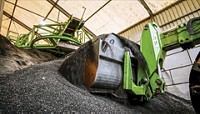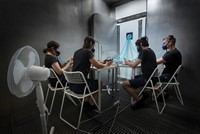Advertisement
Grab your lab coat. Let's get started
Welcome!
Welcome!
Create an account below to get 6 C&EN articles per month, receive newsletters and more - all free.
It seems this is your first time logging in online. Please enter the following information to continue.
As an ACS member you automatically get access to this site. All we need is few more details to create your reading experience.
Not you? Sign in with a different account.
Not you? Sign in with a different account.
ERROR 1
ERROR 1
ERROR 2
ERROR 2
ERROR 2
ERROR 2
ERROR 2
Password and Confirm password must match.
If you have an ACS member number, please enter it here so we can link this account to your membership. (optional)
ERROR 2
ACS values your privacy. By submitting your information, you are gaining access to C&EN and subscribing to our weekly newsletter. We use the information you provide to make your reading experience better, and we will never sell your data to third party members.
Pollution
Movers And Shakers
Air quality expert Richard L. Corsi discusses the complexity of cleaning indoor air
If you’ve seen—or built—a DIY air filter box, you can probably thank this University of California, Davis, engineering dean
by Carolyn Wilke, special to C&EN
June 12, 2022
| A version of this story appeared in
Volume 100, Issue 21

After decades of researching indoor air quality, it’s not the publications and conference presentations that environmental engineer Richard L. Corsi considers his most impactful contributions. Instead, what stands out is an idea from late one summer night in 2020.
During the COVID-19 pandemic, words such as filtration and aerosols filled the public discourse, and concern about indoor air quality mounted. Corsi pondered how to make high-quality filtration more accessible for those who couldn’t afford high-efficiency particulate air (HEPA) cleaners, which cost hundreds of dollars. He thought up a simple, cube-shaped device made of air filters on the sides and a box fan on top that draws air through the filters. Corsi shared the idea with reporter Adam Rogers, who wrote about it for Wired. Then Jim Rosenthal, CEO of Tex-Air Filters, put one together.
Vitals
▸ Hometown: Torrance, California
▸ Current position: Dean, College of Engineering, University of California, Davis
▸ Education: BS, environmental resources engineering, Humboldt State University; MS and PhD, civil and environmental engineering, UC Davis
▸ Favorite molecule: “I think squalene is a really cool molecule. There are some indications that when ozone reacts with squalene in our skin oil—a very large molecule that’s very unsaturated—you get all sorts of interesting by-products depending on where on the squalene molecule it reacts.”
▸ Hobbies: Writing songs, playing the guitar, and “training behaviorally challenged dogs”
▸ Common home appliance that contributes to poor indoor air quality: Gas stoves. “If you’re burning with gas stoves, you’re going to generate a huge amount of ultrafine particles, oxides of nitrogen, and some carbon monoxide. If you overcook your food, you can form polycyclic aromatic hydrocarbons that are largely in a particle phase.”
▸ Memorable quote he’s heard about improving air quality: “If there is a pile of manure in a space, do not try to remove the odor by ventilation. Remove the pile of manure.”—19th-century German researcher Max Joseph von Pettenkofer
The device, dubbed the Corsi-Rosenthal box, costs around $60 to make. In April, Corsi and colleagues reported that such boxes built with filters rated as MERV (minimum efficiency reporting value) 13 deliver clean air at a rate of around 2.5 times that of commercial HEPA cleaners (Aerosol Sci. Technol. 2022, DOI: 10.1080/02786826.2022.2054674). Meanwhile, the boxes have popped up all over social media, with even grade-schoolers crafting them for their homes and classrooms. “The impacts of this idea are more significant than any research I’ve ever done,” Corsi says.
Corsi has long advocated for paying more attention to indoor air. He’s studied volatile organic compounds and indoor ozone—which often comes from outside—and how to remove that pollution using catalytic materials. And he’s advocated for the creation of indoor air quality standards. Carolyn Wilke talked with Corsi about the difficulty of cleaning air and how the pandemic has shifted the conversation on indoor air pollution. The following interview was edited for length and clarity.
Why should we care about indoor air quality?
The average American lives to be 79, and we spend almost 70 of our 79 years of life inside buildings. We spend 54 of those 79 years inside of the homes that we live in. Study after study since the 1980s has shown that levels of most pollutants that are heavily regulated outdoors are present indoors at comparable levels or higher. So most of the air pollution that we breathe during our lifetimes we breathe while we’re indoors. That goes for pollution of outdoor origin as well. It goes through cracks in building envelopes, under doors, and through open windows, and then we breathe it while we’re inside.
One of the things that really excited me about this field is that if we designed and operated buildings with human health in mind, we could dramatically reduce our exposure to outdoor air pollutants. And if we rethink the kinds of materials and products we bring into buildings, we can also dramatically reduce our exposure to pollutants of indoor origin.
What chemicals are thought to contribute to most of the health problems linked to indoor air?

In the last decade or so, there’s been a lot of focus on semivolatile organic compounds in indoor environments, particularly endocrine-disrupting ones. These are some plasticizers, as well as flame retardants and pesticides. We tend to find them in much higher levels indoors than outdoors.
For more than 20 years, there’s been a lot of interest in oxidants in the indoor environment, particularly ozone that comes from outside. We know that ozone sees a lot of things in the indoor environment to react with chemically: latex paint, carpet fibers, cooking oils that coat walls and kitchens, air fresheners, certain cleaners, our skin, and skin flakes, which are a large fraction of dust.
There are literally hundreds of products from those reactions. There is so little toxicological data on those substances that it’s not really clear how significant that chemistry is. But there are enough reaction products that look like chemicals that do cause health concerns that there are red flags.
How should we approach cleaning the air in buildings?
Understanding pollution sources and trying to get rid of the harmful ones should be the first thing. The second thing is ventilation to keep levels of indoor-generated pollution as low as possible. The problem with ventilation is that outdoor air pollution can be pretty bad sometimes. So you increase the amount of outdoor air, but you’re potentially bringing in a lot of pollutants.
The third is good engineering control technology for when you can’t or shouldn’t ventilate more. The most common control technology is for indoor particles—and that’s filtration. It’s a proven technology.
Controlling gases is a lot more complicated. There are devices, usually with activated carbon, for removing volatile organic compounds that also remove any gas-phase semivolatile organic compounds, although those compounds really like to associate with surfaces, like the surfaces of particles. The problem is that a lot of engineered devices don’t have enough activated carbon. There are some technologies that attempt to remove oxides of nitrogen from air, and those are usually activated carbon that’s been impregnated with some chemicals.
My research and the research of some others has focused on ozone. I’ve found, for example, that kaolinite, a clay product, is really effective at catalytically decomposing ozone. It never gets spent, and it’s also good for removing organic acids from the air that can degrade works of art.
How has the pandemic reshaped how we think about and ameliorate indoor air quality?
It’s changed the field. Suddenly, the public and policy makers are in tune with what happens inside buildings. The public is now learning about ventilation and filtration. There are a lot of people who have never worked in indoor air quality who have been world-class outdoor air pollution researchers, and they’re suddenly really interested in indoor air quality. That will allow digging deeper, because there’s so many unanswered questions that those in our field just haven’t been able to get far enough into.

Carolyn Wilke is a freelance writer based in Chicago who covers chemistry, materials, and the natural world. A version of this story first appeared in ACS Central Science: cenm.ag/corsi.





Join the conversation
Contact the reporter
Submit a Letter to the Editor for publication
Engage with us on Twitter